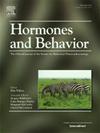Adjustment of paternal care in response to experimental variation in extra-pair mating opportunity in male zebra finches
IF 2.4
3区 医学
Q2 BEHAVIORAL SCIENCES
引用次数: 0
Abstract
Extra-pair paternity is prevalent in socially monogamous bird species with biparental care. Male extra-pair matings may coincide with paternal care provisioned to within-pair offspring. This may lead to a trade-off between obtaining additional fertilizations and securing offspring growth and survival through paternal care. In this pre-registered study, we manipulated the social environment of zebra finches to investigate how males trade off extra-pair mating versus providing paternal care. We compared paternal care provision between a social environment where two pairs bred together in a cage—resulting in an opportunity for extra-pair mating (Double-pair group)—to one with single breeding pairs (Single-pair group). We additionally measured plasma testosterone and corticosterone to identify hormonal correlates of male behavioral responses. To further increase the opportunity for extra-pair mating for the focal males from the Double-pair group we removed the male of the non-focal pair during chick rearing by the focal males. Contrary to our predictions, Double-pair males incubated more than Single-pair males. While we found substantial extra-pair paternity in the Double-pair group after removal of the non-focal males, male brood provisioning, chick growth and survival, and testosterone levels were not affected by the experimental increase in male extra-pair mating opportunity. Corticosterone levels were higher in Single-pair males between the first and replacement clutch. Refuting common assumptions, our findings provide no experimental evidence for a trade-off between extra-pair mating and paternal care. Males were able to pursue extra-pair fertilizations while they simultaneously secured the growth and survival of their within-pair offspring.
雄性斑胸草雀对配对外交配机会的实验变化对父权照顾的调整
在双亲本照顾的一夫一妻制鸟类中,额外的父系关系很普遍。雄性的配偶外交配可能与雄性对配偶内后代的照顾相一致。这可能导致在获得额外受精和通过父系照顾确保后代生长和生存之间的权衡。在这项预先登记的研究中,我们操纵了斑胸草雀的社会环境,研究雄性斑胸草雀如何权衡额外配对交配与提供父亲照顾。我们比较了两种社会环境中的父系抚育,一种是两对在笼子里一起繁殖,从而有机会进行额外的交配(双对组),另一种是单对繁殖(单对组)。我们还测量了血浆睾酮和皮质酮,以确定男性行为反应的激素相关性。为了进一步增加双对组中焦点雄的额外配对机会,我们在焦点雄饲养雏鸟期间将非焦点雄移除了。与我们的预测相反,双配对的雄性比单配对的雄性孵化更多。虽然我们在双对组中发现了大量的额外配对父权,但雄性的产卵量、小鸡的生长和存活以及睾丸激素水平并没有受到雄性额外配对交配机会的影响。在第一窝和替换窝之间,单对雄鼠的皮质酮水平较高。与通常的假设相反,我们的研究结果没有提供实验证据来证明额外配对交配和父亲照顾之间的权衡。雄性能够追求额外的配对受精,同时确保其配对内后代的生长和生存。
本文章由计算机程序翻译,如有差异,请以英文原文为准。
求助全文
约1分钟内获得全文
求助全文
来源期刊

Hormones and Behavior
医学-行为科学
CiteScore
6.70
自引率
8.60%
发文量
139
审稿时长
91 days
期刊介绍:
Hormones and Behavior publishes original research articles, reviews and special issues concerning hormone-brain-behavior relationships, broadly defined. The journal''s scope ranges from laboratory and field studies concerning neuroendocrine as well as endocrine mechanisms controlling the development or adult expression of behavior to studies concerning the environmental control and evolutionary significance of hormone-behavior relationships. The journal welcomes studies conducted on species ranging from invertebrates to mammals, including humans.
 求助内容:
求助内容: 应助结果提醒方式:
应助结果提醒方式:


